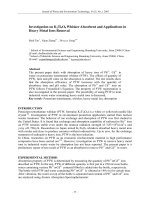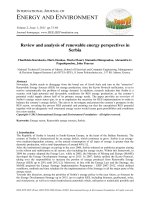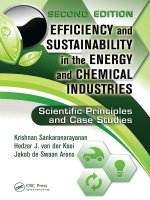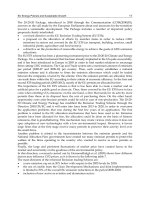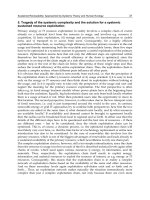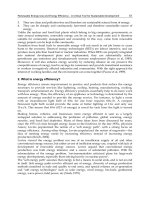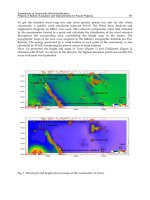Sustainable Growth and Applications in Renewable Energy Sources Part 11 docx
Bạn đang xem bản rút gọn của tài liệu. Xem và tải ngay bản đầy đủ của tài liệu tại đây (4.36 MB, 20 trang )
Energetic Willow (Salix viminalis) – Unconventional Applications
191
Fig. 4. Nitrogen adsorption isotherm at -196
0
C for bare Salix viminalis wood finally
carbonized at 700
0
C. I type isotherm characteristic for the presence of nanopores.
Fig. 5. Nitrogen adsorption isotherm at -196
0
C for activated Salix viminalis wood
(phosphoric acid treatment) finally carbonized at 700
0
C. I type isotherm characteristic for
the presence of nanopores.
Sustainable Growth and Applications in Renewable Energy Sources
192
Fig. 6. Pore size distribution function (PSD) determined from low temperature (-196
0
C)
nitrogen adsorption data by means of Hortvath-Kawazoe method (Horvath & Kawazoe,
1983).
The Salix viminalis originated CMSs proved their sieving properties in gas mixture
separation to single components in chromatographic conditions (Gorska, 2009). For example
table 9 contains separation coefficients determined for N
2
/CH
4
binary gas mixture over two
example Salix viminalis originated CMSs of similar surface area. The separation is of
industrial importance since natural gas resources are often contaminated by nitrogen which
high content may reduce commercial value of methane. The values are dramatically bigger
than 1 at all investigated temperatures i. e. 30, 40, 50, 60 and 70
0
C. It is to emphasize that
separation is very efficient at highest temperature of 70
0
C. It is particularly important
regarding a potential application of such carbons as and adsorbing bed in a PSA (Pressure
Swing Adsorption) installation. In the PSA method, the first step consists in the compression
of a gas mixture to be separated in the adsorbing chamber (filled with CMS). Gas
compression is an exothermal process leading to the warming of gases and carbon
adsorbent what is an undesired phenomenon since separation at high temperature is
generally much worse since PSA separation of air is very temperature sensitive (Japan
EnviroChemicals Ltd., 2011).
Energetic Willow (Salix viminalis) – Unconventional Applications
193
The described fabrication of CMSs does not exploit both unique features of Salix viminalis
i. e. the unique ability of Salix viminalis biomass transformation into a CMS and the Salix
viminalis ability to heavy metal ion accumulation. Both feature were exploited in the case
of a series of hybrid carbon-metal oxide catalysts obtained according to the fabrication
procedure proposed recently by Łukaszewicz et al., 2007. The novelty of the method
consists in the exploitation of natural phenomenon of metal ion transportation in living
plants for the introduction of a metal-based catalytic phase. Metal ions, after introduction
to transport-responsible tissues in a living plant (Salix viminalis), are transported to the
plant cells. The process was efficient since Salix viminalis was highly tolerant to the
presence of heavy metal ions in its body. Freshly cut ca. 20 cm longs sections of a stem
(rootless) of Salix viminalis were immersed (vertical alignment) in a water solution
containing equimolar quantities of La(NO
3
)
3
and Mn(NO
3
)
2
(example concentrations:
0.001M, 0.01M, 0.1M). The stems were fresh enough to preserve intensive metal ion
transport resulting in a gradual rise of the solution along the treated stems. A contrast dye
was added to the solutions in some experiments to provide eye observation of the
capillary rise of solutions along the treated stems. One the other hand, the length of stems
was short enough to avoid differentiated distribution of metal ions in the stem what
might be expected regarding some former tests (see figs 1 and 2). After the contact with
La
3+
and Mn
2+
ion solutions, the metal saturated stems were dried, diminished and
carbonized (600-800 °C, a two-step procedure) in an inert gas atmosphere (N
2
). The first
carbonization let to expel volatile species and to transform the wood (lignin-cellulose
matrix) into carbon matrix (CMS resembling), consisting mainly of C, O, N and H atoms
(Gorska, 2009). The next heat treatment (1 h, N
2
flow) at the temperature of 800 °C did not
destroy already developed pore structure (preliminary carbonization) and, what is the
most important, it enabled the transformation of introduced metal ions into the
corresponding metal clusters. XPS and XRD analysis (Cyganiuk et al., 2010) proved that a
complex oxide LaMnO
3
was synthesized from introduced ions. SEM and HRTEM
investigations proved that the provskite-type oxide is present in such obtained samples in
form of inorganic nano-crystallites suspended in carbon matrix, which in general was an
amorphous material with few graphite nano-crystallites (figs 7 an 8).
Carbon 1 [S
BET
= 312 ± 9.5 m
2
/g] Carbon 2 [S
BET
= 358 ± 10.94 m
2
/g]
Temp [°C] Rs
ΔRs
Rs
ΔRs
70 3.64 0.31 4.80 0.75
60 3.55 0.24 4.71 0.26
50 3.74 0.62 4.91 0.19
40 3.83 0.53 5.25 3.52
30 4.17 0.34 5.87 0.01
Table 9. Separation factors determined the separation of N
2
/CH
4
binary gas mixtures.
Separating medium – Salix viminalis originated carbons. Specific surface area S
BET
determined by BET method from low temperature (-196
0
C) nitrogen adsorption. Calculated
from data collected by Gorska, 2009.
Sustainable Growth and Applications in Renewable Energy Sources
194
Fig. 7. HRTEM image of a LaMnO
3
crystallite embedded in the carbon matrix.
Energetic Willow (Salix viminalis) – Unconventional Applications
195
Fig. 8. HRTEM image of a LaMnO
3
crystallite embedded in the carbon matrix. Crystalline
domains (graphite crystallites) visible in the amorphous carbon matrix.
Sustainable Growth and Applications in Renewable Energy Sources
196
Fig. 9. Identical distribution of Mn (left) and La (right) atoms in hybrid C/LaMnO
3
catalyst.
Fig. 10. SEM and SEM-EDS/EDX analysis of hybrid C/Ce catalysts obtained from Salix
viminalis: a – SEM micrograph, b –distribution of oxygen atoms determined by SEM-
EDS/EDX, c - distribution of cerium atoms determined by SEM-EDS/EDX, d – elemental
analysis of the hybrid material.
Energetic Willow (Salix viminalis) – Unconventional Applications
197
Fig. 11. SEM and SEM-EDS/EDX analysis of hybrid C/Ti catalysts obtained from Salix
viminalis: a – SEM micrograph, b –distribution of oxygen atoms determined by SEM-
EDS/EDX, c - distribution of titanium atoms determined by SEM-EDS/EDX, d – elemental
analysis of the hybrid material.
Such obtained hybrid materials were tested as catalysts for n-butanol conversion to a 4-
heptanone according to the reaction:
2 RCH
2
OH → 2 RCHO → RCOR
The catalysts exhibited very good catalytic performance despite very low concentration of
the active component i. e. a perovskite-type oxide LaMnO
3
(atomic content below 1%). The
noticed high activity i. e. yield and selectivity (Cyganiuk et al., 2010) resulted from very high
dispersion of the active phase understood as:
- - reduced size of LaMnO
3
crystallites (10-100 nm),
- - uniform distribution of both metals in the carbon matrix (fig. 9).
Similarly, titanium and cerium based hybrid materials were obtained by exploitation of metal
ion transportation in living parts of Salix viminalis (ca. 20 cm long stem sections). Figs 10 and
11 depict uniform distribution of Ce and Ti atoms in a carbon matrixes. Their occurrence is
accompanied by oxygen atoms however the latter are a usual constituent of carbon matrixes
and can not be exclusively associated with Ce and Ti in the form of metal oxides. Elemental
analysis data definitely prove (figs 10 and 11) that Ce and Ti are present in investigated hybrid
Sustainable Growth and Applications in Renewable Energy Sources
198
samples and their presence result only from the performed fabrication procedure. The
elements are relatively rare and have not been found in the samples of non-impregnated but
carbonized Salix viminalis wood. Also in this case the atomic content of the metals is very low i.
e. definitely below 1% despite of the concentration of impregnating solution. Thus, the
proposed exploitation of metal ion transport in living parts of Salix viminalis ensures rather low
level of impregnation but of very high dispersion. The Ti and Ce containing hybrid materials
were tested as catalysts, too. Both materials despite of the same properties of carbon
component of them, exhibited dramatically different catalytic activity:
- Ti/C hybrids towards dehyration of n-alcohols (n-butanol conversion to butane, ca.
55% selectivity at 460
0
C),
- Ce/C hybrids towards ketonization of n-alcohols (n-butanol conversion to heptanone-4,
ca. 75% selectivity at 460
0
C).
The differences must by attributed to different catalytic properties of the active components
of the hybrid materials i. e. to Ce and Ti derivatives (mixed oxides) which presence was
proved by XRD, XPS and HRTEM measurements.
In summary, the proposed hybrid catalysts fabrication method is basing on two important
and exclusive features of Salix viminalis:
- high vitality preserving some living functions like metal ion transportation in fragments
of a complete plant (single rod cut into 20 cm long pieces),
- high tolerance of still living parts of Salix viminalis to heavy metal ions which enter the
plant structure. We assume that toxic influence of the heavy metal ions is considerably
reduced in the plant cells otherwise transportation of metal ions could be severely
disrupted and finally terminated. During impregnation in most Salix viminalis samples
(sections of rod) no visible morphological changes were observed and the 20 cm long
sections retained their original olive-green color characteristic for its bark. Visible bulge
and shrinkage did not occur.
The originality of the above presented concept let to submit patent applications
(Łukaszewicz et al., 2006; Łukaszewicz et al., 2007).
3.2 Dry distillation of Salix viminalis wood
Fabrication of charcoals from Salix viminalis consists in the a heat treatment of the biomass in
oxygen free conditions. In fact this process can be also called dry distillation w wood.
However, usually distillation is run aiming at the collection of volatile products which
evolve during heat treatment. Looking at charcoal fabrication (described above) from such a
point view authors has decided to cool down (liquefaction) volatiles leaving heating zone of
stove along with the stream of inert gas (nitrogen) passing through the stove. The
condensate in form of a dark brown viscous liquid was collected in a glass beaker and
subsequently subjected to several analysis. We assumed that the condensate is a mixture of
numerous organic compound as in the case of wood tar obtained by dry distillation of other
sorts of wood i. e. pine (Egenberg et al., 2002).
At the beginning we assumed that the collected tar must contain phenols and polyphenols
which are created during thermolysis of lignin (de Wild et al., 2010). Salix viminalis wood
contains ca. 20-24 % (by weight) of lignin in dry mass of wood (Mleczek et al., 2010). The
distillate called biooil was subjected to some separation measures like extraction to isolate
several fractions containing polyphenols. Polyphenols are a precious group of compounds
mainly because of their antioxidant properties.
Energetic Willow (Salix viminalis) – Unconventional Applications
199
3.3 Polyphenols and other antioxidants
Free radicals play important role in the functioning of human organism (Grajek, 2007).
However, their presence may be the reason of oxidative stress. The stress often results from
disrupted balance between peroxidants and antioxidants in an organism. It is proven that
high activity of free radicals and prolonged influence of oxidative stress are responsible for
pathogenesis of nearly 100 diseases (Wolski, 2007) including Alzheimer and Parkinson
diseases (Bartosz, 2008; Fitak & Grzegorczyk-Jaźwińska, 1999). During ageing oxidative
damages in cells become more frequent with parallel reduction the activity of antioxidative
enzymes. The situation becomes worse due to UV irradiation, environmental pollution,
permanent mental stress and bad nutrition habits. Oxygen being the base of human
existence is mainly available in it triplet form O
2
**
. The electron configuration results in
moderate chemical activity in contrast to other forms like (O
2
*)
-
, HO
2
* and OH*. The latter
form is considered as the most reactive. Proper enzymes ensure control over 98-99% of all
oxygen in a human body. However, the remaining amount of oxygen may undergo
transformation (Fenton reaction, Haber-Weiss reaction) into the most reactive forms i. e.
oxygen derivatives being free radicals. Daily up to 10 thousand DNA oxygen-related
damages occur in a human body. The damages may be repaired by some specific enzymes
but the introduction of antioxidants should reduce the threat. Therefore everyday diet has to
be supplemented by natural antioxidants. Antioxidation properties of polyphenols may
involve the three general mechanisms:
- direct expunge of reactive form of oxygen and nitrogen by two possible pathways:
Single Electron Transfer (SET) or Hydrogen Atom Transfer (HAT). In such processes a
polyphenol molecule transforms into a phenoxyl radical which after reaction with a
next oxygen radical stabilizes as chinone like structure (fig. 12)
- chalation of transition metal ions (particularly copper and iron) which participate in the
reactions leading to the formation of reactive radicals like the Fenton reaction involving
Fe
2+
ions and yielding dangerous hydroxyl radical OH,
- increasing of concentration of endogenous antioxidants and/or inhibition of enzymes
stimulating the formation of free radicals.
Such positive chemical features of polyphenols turns peoples attention towards intensive
search for sources of them and the development of methods of polyphenols separation
from their natural matrixes for further enrichment of some products like pharmaceuticals,
food, cosmetics etc. This way of thinking involves investigations on appropriate plants i.
e. candidates for a subsequent chemical treatment like polyphenol extraction. According
to some extended studies (Makowska-Wąs & Janeczko, 2004) polyphenols occur in many
plants and plant originated products like herbs, needles of coniferous plants, algae, green
tea leaves, eucalyptus wood, byproducts of olive, wine, yeast production. It is obvious
that chemical exploitation of one source plant yields a limited number of polyphenols and
search for other polyphenols needs a selection and a proper treatment of another source
plants. It has to be stated that the polyphenol content in source plants is very
differentiated but also very low. Table 10 informs about the antioxidant activity
determined for 100 g of example fruits and vegetables. The highest activity is noticed for
pure vitamins and synthetic antioxidants. However, the mentioned products owe their
antioxidative activity not only due to the presence of polyphenols since other type of
antioxidants may be present, too.
Sustainable Growth and Applications in Renewable Energy Sources
200
Fig. 12. Oxygen based free radical reaction with a polyphenol.
Obviously the above list is not closed and other natural and synthetic products may be
addend and therefore search for other effective products is fully justified. Authors
attention has turned towards chemical processing of some easily accessible and renewal
resources. Our primary idea was to involve chemical processing not limited to the
separation of already existing polyphenols (a passive approach) but also on treatments
that transform original matter of low polyphenol content into a new product of high
polyphenol concentration (active approach). Such a concept focused our attention on
Salix viminalis again due to its inexpensiveness, renewal cultivation and high content of
lignin which thermal treatment releases polyphenols. As the matter of fact Salix viminalis
as a living plant contains some amounts of different polypneols like flavonoides
(flavanols, flavones, flavonones, flawonone dimers, chalcones), phenolic acids, lignans,
catechin and its derivatives as well as tannins (procyanidins, prodelfinidins) being
derivatives of flavan-3-ols. Particular Salix species differ much regarding the total
content of polypheneols (Nyman & Julkunen-Tiitto, 2005) and their type (Landucci et al.,
2003).
For example Salix caprea contains variety of flavonoids and the lack of lignans (Pohjamo et
al., 2002). Contrastly, for Salix viminalis characteristic are relatively low concentrations of
flavonoids (Harborne & Baxter, 1999), moderate concentrations of lignans (Pohjamo et al.,
2003) and high concentrations of tannins (Nikitina & Orazov, 2001).
Energetic Willow (Salix viminalis) – Unconventional Applications
201
Food produkt
Antioxidant activity
[TE/100 g]
Red Grapes 1350
Red Cabbage 1000
Broccoli Flowers 500
Spinach 500
Green Grapes 400
Tomato 300
Green Beans 175
Green Cabbage 150
Lima Beans 1055
Red Beans 11459
Blueberries 3300
Raisins 5900
Wheat Bran 4620
Wheat Flour (refined) 600
Substance
Antioxidant activity
[TE/100 g]
Ascorbate 442 000
Trilox 400 000
Witamin E 201 000
BHT 395 000
TE – TRILOX Equivalent
TRILOX
Table 10. Antioxidant activity of selected food products, vitamins and synthetic
antioxidants. Selected points cited after (Prakash et al., 2010).
Sustainable Growth and Applications in Renewable Energy Sources
202
The concentration of polyphenols in Salix viminalis depends also on the season of the year.
t maximal concentration of flavonoids is reached during blossom while tannins
concentration is highest in Autumn (Nikitina & Orazov, 2001). Long exposure of Salix
viminalis to sunshine (UV radiation) additionally increases the content of compounds
capable to neutralization of free radicals (flavonoids, phenolic acids, proantocyanidynes)
and reduces the content of salicylic acid and its derivatives (Tegelberg & Julkunen-Titto,
2001). Thus, a proper cultivation of Salix viminalis and well planned collection of
polyphenols by extractive methods may result in a better efficiency of the whole attempt.
However, as mentioned earlier, the total contents of polyphenols is relatively low and
therefore the mass of isolated antioxidants in relation to the mass of raw material is
dramatically low. Thus, the contemporary chemical technology should not only rely on
the Nature’s productivity but also search for more effective methods of polyphenols
fabrication instead of collection. The heat-treatment of Salix vimanlis wood yields three
basic products (charcoal, biooil, biogas) but yield of each depends on heating rate as
depicted in fig. 13).
As mentioned biooil formation is a result of lignin pyrolysis. Lignin is biopolymer (fig.
14) consisting of some characteristic units i. e. p-cumarol alcohol, coniferyl alcohol,
synapine alcohol (fig. 15.) bonded by various organic bridges. Thus, the bonds may
break at different point yielding a huge number of organic compounds including
polyphenols. Volatile products evolve during heat-treatment with unequal intensity (fig.
16). The most intensive collection of liquid condensate is possible in the temperature
range of 260-380 °C).
Fig. 13. Typical products of biomass pyrolysis. The influence of process conditions (heating
rate, temperature) on yield of particular products.
Energetic Willow (Salix viminalis) – Unconventional Applications
203
Fig. 14. Pattern structure of lignin.
Fig. 15. Structures of three phenolic alcohols being monomers in lignin: A – p-cumarol
alcohol, B – coniferyl alcohol, C – synapine alcohol.
Sustainable Growth and Applications in Renewable Energy Sources
204
Fig. 16. The intensity of liquid condensate yield (biooil) at different temperatures.
The such collected fraction was considered as a raw biooil subsequently subjected to
separation (extraction, chromatography) procedures and chemical characterization. Several
instrumental methods were applied: gas chromatography GC-MS (Autosystem XL - MS
Turbomass), nuclear magnetic resonance
1
H and
13
C NMR (700 MHz Bruker Avance) and
infrared spectroscopy FT-IR (Perkin Elmer Spectrum 2000). Additionally the isolated
fractions were tested as antioxidants according to ASTM 4871 standard
(www.astm.org/Standards/D5770.htm, 2011). The latter procedure consists in the oxidation
of a standard substance DBS (dibuthyl sebacate) in liquid phase at relatively severe
conditions (150
0
C, constant flow of air 100 cm
3
/min). The oxidation may proceed in the
presence (1000 ppm) of different protective antioxidants including separated fractions of
raw biooil of Salix viminalis origin (dry distillation) and some commercially distributed
antioxidants like BHT (2,6-di-tert-buthyl-p-cresol, buthyl hydroxy toluene, buthylated
hydroxy toluene). BHT is widely used for the protection and stabilization of cosmetics and
food products. The most promising results were achieved so far for two extracts called A
and B (ethyl ether and dichloromethane extracts respectively).
The results of a complex analysis (GC-MS, NMR, FTIR, UV-VIS) of both extracts confirm
that:
- each extract contains ca. 50 different compounds which may exhibit antioxidative
properties,
Energetic Willow (Salix viminalis) – Unconventional Applications
205
- most of the potential antioxidats are in fact derivatives of three organic structures
(cumarol alcohol, coniferyl alcohol, synapine alcohol) which are claimed to be units of a
the biopolymer occurring in Salix viminalis wood i. e. lignin (see text above); the
compounds are released from the wood sample due to thermolysis of the biopolymer -
lignin,
- the extract B contains more furan derivatives while the extract A contains more oxygen
heterocyclic compounds.
The determination of the composition of the two preliminary extracts A and B has a
certain chemical value but more important is to confirm if the extract theoretically
consisting of antioxidant species can exhibit efficient antioxidant activity, what is the main
motivation for this research. The absence of such activity could question the whole
research attempt which from early beginning was focused on a practical aspects i. e. on
the applicability of all products of the dry Salix viminalis wood pyrolysis. The preliminary
hypothesis was confirmed by the performed controlled oxidation tests (fig. 17). It is
visible that the addition of 1000 ppm of a commercial antioxidant i. e. BHT protects the
test substance DBS for ca. 50 hours. After this time one observes increasing concentration
of some oxidation products in the reaction chamber. In the same experimental conditions
pure DBS undergoes instant oxidation without any significant protection time. The
addition of the biooil extract B in the same proportion of 1000 ppm extends threefold the
protection time. Thus, DBS was protected nearly for one week despite sever experimental
conditions. It has to be stated that the protection times for much lower temperatures like
room temperature must by very long.
Fig. 17. Restraining of DBS oxidation by means of extract B and BHT.
Sustainable Growth and Applications in Renewable Energy Sources
206
4. Summary
The performer research program prove that Salix viminalis is a precious raw material for
chemical treatment and it could not be seen only as a fuel for energetic utilization. Its
practical value increases regarding that it is easily accessible as agriculture product. It grows
fast with a good yield. Salix viminalis cultivation has a positive influence on the environment
since their high mass productivity per hectare is definitely associated with CO
2
absorption
from the atmosphere. The proposed elaboration method is nearly complete since all major
products of the wood thermolysis i. e. solid (active carbon of CMS properties) and liquid
(biooil containing antioxidants) may find a wide application in practice.
5. References
Anderson T.A., Guthrie E.A., Walton B.T. (1993). Bioremediation. Environ. Sci. Technol., 27,
(13), pp. (2630-2636), ISSN:0013-936X.
Baker A.J.M., Walker P.L. (1990). Ecophysiology of metal uptake by tolerant plants, heavy
metal tolerance in Plants. In: Evolutionary Aspects. Shaw A.J., pp (155-177), ISBN:1-
84405-143-9, CRC Press, Boca Raton.
Bartosz G. (2008). Druga twarz tlenu (II). Państwowe Wydawnictwo Naukowe, ISBN 978-
83-01-13847- 9, Warsaw.
Bio-energia. (2008). www.bio-energia.pl.
Blaylock M.J., Slat D.E., Dushenkov S., Zakharova O., Gussman C., Kapulnik Y., Ensley B.D.,
Raskin I. (1997). Enhanced accumulation of Pb in Indian mustard by soil applied
chelating agents. Environ. Sci. Technol., 31 (3), pp. (860-865), ISSN: 0013-936X.
Borjesson P., Gustavsson L., Christersson L., Linder S. (1997). Future production and
utilization of biomass in Sweden: Potentials and CO
2
mitigation. Biomass Bioenerg.,
13, (6), pp. (399-412), ISSN: 0961-9534.
Brown S.L., Chaney R.L., Angle J.S., Baker A.J.M. (1994). Phytoremediation potential of
Thlaspi caerulescens and bladder campion for zincand cadmium-contaminated soil.
J. Environ. Qual., 23, (6), pp. (1151-1157), ISSN: 0047-2425.
Christersson L., Sennerby-Forsse. (1994). The swedish programme for intensive short
rotation forests. Biomass Bioenerg., 6, (1-2), pp. (145-149), ISSN: 0961-9534.
Clemens S. (2006). Toxic metal accumulation, responses to exposure and mechanisms of
tolerance in plants. Biochimie, 88, (11), pp. (1707–1719), ISSN: 0300-9084.
Cyganiuk A., Klimkiewicz R., Olejniczak A., Łukaszewicz J.P. (2010). Biotechnological
fabrication of LaMnO3-carbon catalyst for n-butanol conversion to ketones. Carbon,
48, (1), pp. (99-106), ISSN 0008-6223.
Dushenkov V., Kumar P.B.A.N., Motto H., Raskin I. (1995). Rhizofilteration the use of plants
to remove heavy metals from aqueous streams. Environ. Sci. Technol., 29, (5), pp.
(1239-1245), . ISSN:0013-936X.
Egenberg I.M, Aasen J.A.B., Holtekjølen A.K., Lundanes E. (2002). Characterisation of
traditionally kiln produced pine tar by gas chromatography-mass spectrometry. J.
Anal. Appl. Pyrolysis, 62, (1), pp. 143-155, ISSN: 0165-2370.
Fitak E., Grzegorczyk-Jaźwińska A. (1999). Wolne rodniki i ich aktywność w układach
biologicznych. Nowa Stomatologia, 3, pp. (27-30), ISSN: 1426-6911.
Gąsecka M., Mleczek M., Magdziak Z., Drzewiecka K., Goliński P., Chadzinikolau T.
Physiological and Morphological Changes in Salix viminalis as a Result of Plant
Energetic Willow (Salix viminalis) – Unconventional Applications
207
Exposure to Copper. Proc. 15th ICHMET, ISBN: 9788392898658, pp. (350-353),
Gdańsk, September 2010.
Górska O.M. (2009). Wybrane surowce naturalne jako potencjalne źródło do otrzymywania
materiałów węglowych o właściwościach sitowo-molekularnych. Master thesis.
Wydział Chemii UMK, Toruń.
Gradziuk P. (1999). Możliwości wykorzystania surowców pochodzenia rolniczego na cele
energetyczne. Rocz. Nauk. Stow. Ekonom. Roln. Agrobiz., 1, (3), pp. (233-238).
Grajek W. (2007). Przeciwutleniacze w żywności. Aspekty zdrowotne technologiczne
molekularne i analityczne (I). Wydawnictwa Nukowo-Techniczne, ISBN: 97883-
204-32770, Warsaw.
Harborne J.B., Baxter H. (1999). The handbook of natural flavonoids (I). Willey, ISBN: 0-471-
95893-X, Chichester.
Horvath G., Kawazoe K. (1983). Method for the calculation of effective pore size distribution
in molecular sieve carbon. J. Chem. Eng. Jpn., 16, (8), pp. (470-475), ISSN: 0021-9592.
Iso-Tech. (2011). www.biomasa.org.
Japan EnviroChemicals Ltd. (2011). www.jechem.co.jp/shirasagi_e/tech/psa.html.
Kumar P.B.A.N., Dushenkov V., Motto H., Raskin I. (1995). Phytoextractionthe use of plants
to remove heavy metals from soils. Environ. Sci. Technol., 29, (5), pp. (1232-1238),
ISSN:0013-936X.
Landucci L., Ralph S., Hirth K. Characterization and reactions of a Salix extractive with a
unique ring system. Proceedings of 12th Int. Symp. Wood Pulping Chem., vol. III,
pp. (199-202). Madison, June 2003.
Łukaszewicz J P., Arcimowicz A., Klemp-Dyczek B. (2006). Sposób wytwarzania węglowych
sit molekularnych. Patent application P 380164, Polish Patent Office.
Łukaszewicz J.P., Wesołowski R., Arcimowicz A. (2007). Metoda otrzymywania węglowych
sit molekularnych wzbogaconych w nanokrystality tlenków metali zwłaszcza do
budowy elektrod w urządzeniach elektrochemicznych. Patent application P 384122,
Polsih Patent Office.
Łukaszewicz J.P., Wesołowski R. (2008). Fabrication of Molecular-Sieve-Type Carbons from
Salix viminalis. Microporous and Mesoporous Mater., 111, (1-3), pp. (723-726),
ISSN: 1387-1811.
Łukaszewicz J.P., Wesołowski R., Cyganiuk A. (2009). Enrichment of Salix viminalis wood
in metal Ions by means of phytoextraction. Pol. J. Environ. Stud., 18, (3), pp. (507-
511), ISSN: 1230-1485.
Makowska-Wą
s J., Janeczko Z. (2004). Bioavailability of plant polyphenols, Postępy
Fitoterapii, 3/2004, pp. (126-137), ISSN: 1509-8699.
Memon A.R., Aktoprakligul D., Zdemur A., VertiiI A. (2001). Heavy Metal Accumulation
and Detoxification Mechanisms in Plants. Turk. J. Bot., 25, (3), pp. (111-121), ISSN:
1300-008X.
Lasat M.M. (2002). Phytoextraction of toxic metals: a review of biological mechanisms. J.
Environ. Qual., 31(1), pp. (109-120), ISSN: ISSN: 0047-2425.
Mleczek M., Magdziak Z., Rissmann I., Goliński P. (2009). Effect of different soil conditions
on selected heavy metal accumulation by Salix viminalis tissues, J. Environ. Sci.
Health Part A, 44, (14), pp. (1609–1616), ISSN: 1093-4529.
Mleczek M., Kaczmarek Z., Magdziak Z. Goliński P. (2010). Hydroponic estimation of heavy
metal accumulation by different genotypes of Salix. J. Environ. Sci. Health Part A,
45, (5), pp. (569–578), ISSN: 1093-4529.
Sustainable Growth and Applications in Renewable Energy Sources
208
Nikitina V.S., Orazov O.E. (2001). The dynamics of total flavonoids in leaves and tannides in
the bark of branches in heterosexual specimens of Salix triandra L. and S. acutifolia
Willd. Rastitelnye Resursy, 37, (1), pp. (65-72), ISSN: 0033-9946. .
Nyman T., Julkunen-Tiitto R. (2005). Chemical variation within and among six northern
willow species. Phytochem., 66, (24), pp. (2836-2843), ISSN: 0031-9422.
Pilon-Smits E, Pilon M (2000). Breeding mercury-breathing plants for environmental clean-
up. Trends in Plant Sci., 5, (6), pp. (235-236), ISSN: 1360-1385.
Pohjamo S.P, Willfor S., Reunanen M., Hemming J., Holmbom B. (2002). Bioactive phenolic
substances in fast-growing tree species. Abo Akademi. Laboratoriet for
Skogsprodukternas Kemi, B1-02.
Pohjamo S.P., Hemming J.E., Willfor S.M., Reunanen M.H.T., Holmbom B.R. (2003).
Phenolic extractives in Salix caprea wood and knots. Phytochem., 63, (2), pp. (165-
169), ISSN: 0031-9422
Porębska G., Ostrowska A. (1999). Heavy Metal Accumulation in Wild Plants: Implications
for phytoremediation. Pol. J. Environ. Stud., 8, (6), pp. (433-442), ISSN: ISSN: 1230-
1485.
Prakash A., Rigelhof F., Miller E. (2011). Medallion Laboratories. Analytical Progress.
www.medallionlabs.com/Downloads/Antiox_acti_.pdf.
Reski R., Abel, W.O. (1985) Induction of budding on chloronemata and caulonemata of the
moss, Physcomitrella patens, using isopentenyladenine. Planta, 165, (3), pp. (354-
358), ISSN: 0021-9258.
Salt D.E., Blaylock M., Kumar P.B.A.N., Dushenkov S., Ensley B.D., Chet I., Raskin I. (1995).
Phytoremediation: A novel strategy for the removal of toxic metals from the
environment using plants. Nature Biotechnol., 13, (5), pp. (468-474), ISSN: 1087-
0156.
Shah K., Nongkynrih J.M. (2006). Metal hyperaccumulation and bioremediation, Biol.
Plantarum, 51, (4), pp. 618-634, ISSN: 0006-3134.
Smith R.A.H., Bradshaw A.D. (1979). The use of metal tolerant plant populations for the
reclamation of metalliferous wastes. J. Appl. Ecol., 16, (2), pp. (595-612), ISSN: 1365-
2664.
Tegelberg R., Julkunen-Titto R. (2001). Quantitative changes in secondary metabolites of
dark-leaved willow (Salix myrsinifolia) exposed to enhanced ultraviolet-B
radiation. Physiol. Plant, 113, (4), pp. (541-547), ISSN: 0031-9317.
Walton B.T., Anderson T.A. (1992). Plant-microbe treatment systems for toxic waste. Current
Opinion in Biotechnology, 3, (3), pp. (267-270), ISSN: 0958-1669.
de Wild P.J., van der Laan R.R., Wilberink R.W.A. Thermolysis of lignin for value-added
products. Presented
at 15th Meeting of the International Humic Substances Society, Tenerife, June-July
2010.
Wolski T., Kalisz O., Gerkowicz M., Morawski M. (2007). The role and the significance of
antioxidants in medicine with particular respect to eye disorders. Postępy
Fitoterapii, 2, pp. (82-90), ISSN: 1509-8699.
Zabrocki R., G. Ignacek G. (2008). Wykorzystanie wierzby energetycznej w gospodarce
rolnej. Roczniki Naukowe Stowarzyszenia Ekonomistów Rolnictwa i Agrobiznesu.
9, (3), pp. ( 234-238), ISSN: 1508-3535.
10
Biomass Energy Conversion
Sergio Canzana Capareda
Texas A&M University
USA
1. Introduction
The use of biomass as a source of energy varies in different countries and depends in
part on the country’s level of development. In many developing countries, biomass
provides most of the basic energy needs, mostly as fuelwood, animal wastes or crop
residues while in developed countries only a fraction of their energy requirement comes
from agriculture and agro-industrial wastes. In the United States for example, biomass
conversion amounts to about 3.25% of the energy supply (EIA, 2002 and Haq, 2002)
while in Bhutan, the share of biomass energy in total energy use accounts for about 87%
(Victor, and Victor, 2002).
Biomass resources could play a significant role in meeting the future energy
requirements. However, the approach in their utilization should be carefully analyzed in
view of diverse cultural, socio-economic and technological factors in a given locality.
Agricultural and agro-industrial wastes can provide an inexpensive source of energy and
effective low sulphur fuel. It could be processed into other fuels thereby reducing
environmental hazards (e.g. biomass from sewage). Also, there is relative ease with
which it could be gathered and generated. However, the conversion of light energy into
biomass by plants is relatively of small percentage and there is relatively low
concentration of biomass per unit area of land and water. The additional land for
biomass production is getting scarce, and the high moisture content of fresh biomass
makes collection and transport expensive. Thus, biomass energy conversion could be
relatively inefficient. Moreover, extensive utilization of these resources may compete
with the demand for these as food. These are some of the issues concerning the extensive
utilization of biomass resources.
In view of the depleting forest and agricultural resources for energy use, attention should be
focused on new and emerging technologies for their efficient conversion. There are a
number of sources of energy for both rural or agricultural and urban or industrial residues.
There is a need to diversify the traditional resources for energy to meet the demands. These
include, among others: (1) planting high energy value crops, fast growing trees, sugar and
starchy crops, aquatic plants, oil and hydrocarbon crops, and (2) getting energy from
municipal sewage and solid wastes. Some common properties of biomass resources will be
reviewed to gain perspective of biomass as a source of energy compared with traditional
fossil fuel sources.
The primary advantage in the use of biomass as an energy resource is that it is a renewable
feedstock and does not contribute to global warming.
Sustainable Growth and Applications in Renewable Energy Sources
210
2. Biomass properties and characterization
The important biomass properties include the following: (a) heating value, (b) proximate
analysis and (c) ultimate analysis. Any biomass conversion process begins with knowing its
energy content in units of MJ/kg and compared with traditional resources like coal. Further,
biomass resources may be describe based on its proximate analysis whereby its moisture
content (MC) is reported, followed by the volatile combustible matter (VCM) contents, fixed
carbon (FC) and ash. Finally, the ultimate analysis is important to illustrate the biomass
composition in relation to the top five elements it contains as follows: (a) carbon (C), (b)
hydrogen (H) (c) oxygen (O), (d) nitrogen (N) and (e) sulphur (S) content. Other
characterization would include describing its compositional contents such as lignin,
cellulose and hemi-celluloses , carbohydrates and fat contents.
When biomass is converted thermally in the presence of excess amounts of air, (i.e.
combustion) the total energy released in the form of heat is termed its heating value or
calorific value. The heating value of biomass is reported in units of kJ/kg. Gasoline used as
fuel for running internal combustion engines has a reported heating value of about 47
MJ/kg and diesel has heating value of about 45 MJ/kg. Biomass on the other hand may
have heating values ranging from 15 – 25 MJ/kg.
2.1 Heating value and ultimate analysis of biomass
Heating value of biomass is usually measured using a bomb calorimeter. Table 1 shows the
ultimate analyses and heating value of some fossil fuels and common biomass. In the
absence of equipment for measuring heating values of biomass, two most common
equations are used. These are the Dulong equation (Gupta and Manhas, 2008) and the Boie
equation (Annamalai, et al., 1987) shown in equations (1) and (2).
Material
Elements (% dry weight)
Heating
Values
C
H
N
S
O
Ash
MJ/k
g
Pittsbur
g
h seam coal
75.5
5.0
1.2
3.1
4.9
10.3
31.7
Utah coal 77.9
6.0
1.5
0.6
9.9
4.1
32.9
W
y
omin
g
Elkol coal
71.5
5.3
1.2
0.9
16.9
4.2
29.5
Li
g
nite 64.0
4.2
0.9
1.3
19.2
10.4
24.9
Charcoal 80.3
3.1
0.2
0.0
13.0
3.4
57.4
Dou
g
las fir 52.3
6.3
0.1
0.0
40.5
0.8
21.3
Pine bark 52.3
5.8
0.2
0.0
38.8
2.9
20.4
Redwood 53.5
5.9
0.1
0.0
40.3
0.2
21.0
Rice hulls 38.5
5.7
0.5
0.0
39.8
15.5
15.4
Rice straw 39.2
5.1
0.6
0.1
35.8
19.2
15.2
Sawdust 49.7
6.2
0.7
0.2
42.5
0.7
20.0
Paper 43.4
5.8
0.3
0.2
44.3
6.0
17.6
Feedlot manure (fresh)
45.4
5.4
1.0
0.3
32.0
15.9
17.4
Municipal solid waste
47.6
6.0
1.2
0.3
32.9
12.0
19.9
Corn cobs 46.2
7.6
1.2
0.3
42.3
2.4
26.3
Sor
g
hum stalks 40.0
5.2
1.4
0.2
40.7
12.5
15.4
Cotton
g
in trash (CGT)
42.0
5.4
1.4
0.0
36.7
14.5
15.5
Table 1. Ultimate analysis data and heating values for selected solid and biomass fuels (from
LePori and Soltes, 1985, with permission).
